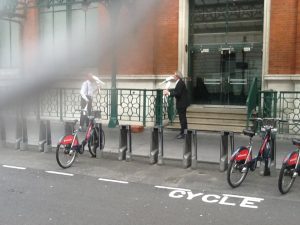I have remarked before that anyone who has spent any extended period living in Africa or Asia will have encountered people with strong beliefs, beliefs based on their own direct, personal experiences, in the existence of a non-material realm. In many places, the overwhelming majority of people have such beliefs. It may be that the majority of westerners, too, have had such experiences but our contemporary culture (pseudo-rationalist materialism arising from a Protestant disdain for the supernatural and pagan aspects of Catholicism) inhibits their public expression, or even, sometimes, their private recognition.
Strangely, my thoughts on this subject I find mirrored uncannily by Lafcadio Hearn (1850-1904), writing 120 years ago. Here is Hearn, writing about Shintô temples in Japan and his reactions to the associated beliefs:
Why certain architectural forms produce in the beholder a feeling of weirdness is a question about which I should like to theorize some day; at present I shall venture only to say that Shintô shrines evoke such a feeling. It grows with familiarity instead of weakening; and a knowledge of popular beliefs is apt to intensify it. We have no English words by which these queer shapes can be sufficiently described, – much less any language able to communicate the peculiar impression which they make. Those Shintô terms which we loosely render by the words “temple” and “shrine” are really [page-break] untranslatable; — I mean that the Japanese ideas attaching to them cannot be conveyed by translation. The so-called “august house” of the Kami is not so much a temple, in the classic meaning of the term, as it is a haunted room, a spirit-chamber, a ghost-house; many of the lesser divinities being veritably ghosts, — ghosts of great warriors and heroes and rulers and teachers, who lived and loved and died hundreds or thousands of years ago. I fancy that to the Western mind the word “ghost-house” will convey, better than such terms as “shrine” and “temple,” some vague notion of the strange character of the Shintô miya or yashiro, — containing in its perpetual dusk nothing more substantial than symbols or tokens, the latter probably of paper. Now the emptiness behind the visored front is more suggestive than anything material could possibly be; and when you remember that millions of people during thousands of years have worshiped their great dead before such yashiro, — that a whole race still believes those buildings tenanted by viewless conscious personalities, — you are apt also to reflect how difficult it would be to prove the [page-break] faith absurd. Nay! In spite of Occidental reluctances, — in spite of whatever you may think it expedient to say or not to say at a later time about the experience, — you may very likely find yourself for a moment forced into the attitude of respect towards possibilities. Mere cold reasoning will not help you far in the opposite direction. The evidence of the senses counts for little: you know there are ever so many realities which can neither be seen nor heard nor felt, but which exist as forces, — tremendous forces. Then again you cannot mock the conviction of forty millions of people while that conviction thrills all about you like air, — while conscious that it is pressing upon your psychical being just as the atmosphere presses upon your physical being. As for myself, whenever I am alone in the presence of a Shintô shrine, I have the sensation of being haunted; and I cannot help thinking about the possible apperceptions of the haunter. And this tempts me to fancy how I should feel if I myself were a god, — dwelling in some old Izumo shrine on the summit of a hill, guarded by stone lions and shadowed by a holy grove. (Hearn 1897, pages 2-4)”
Reference:
Lafcadio Hearn [1897]: Gleanings in Buddha-Fields: Studies of Hand and Soul in the Far East. London, UK: Kegan Paul, Trench, Trubner & Company Limited.
